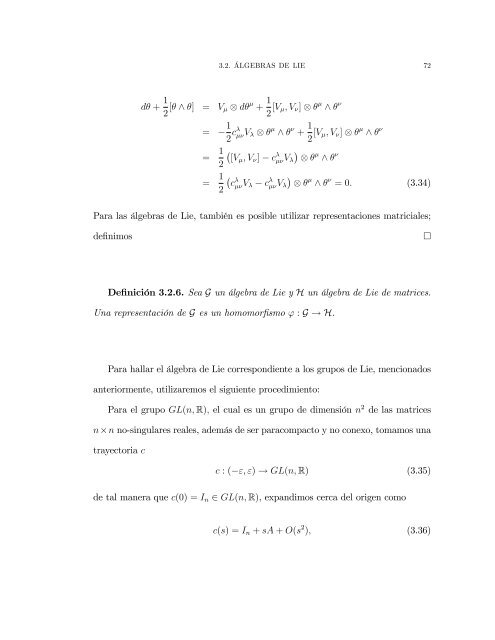INSTITUTO POLITÃCNICO NACIONAL - Instituto Avanzado de ...
INSTITUTO POLITÃCNICO NACIONAL - Instituto Avanzado de ...
INSTITUTO POLITÃCNICO NACIONAL - Instituto Avanzado de ...
You also want an ePaper? Increase the reach of your titles
YUMPU automatically turns print PDFs into web optimized ePapers that Google loves.
3.2. ÁLGEBRAS DE LIE 72d + 1 2 [ ^ ] = V d + 1 2 [V ; V ] ^ =12 c V ^ + 1 2 [V ; V ] ^ = 1 2 [V ; V ] c V ^ = 1 2 c V c V ^ = 0: (3.34)Para las álgebras <strong>de</strong> Lie, también es posible utilizar representaciones matriciales;<strong>de</strong>…nimosDe…nición 3.2.6. Sea G un álgebra <strong>de</strong> Lie y H un álgebra <strong>de</strong> Lie <strong>de</strong> matrices.Una representación <strong>de</strong> G es un homomor…smo ' : G ! H.Para hallar el álgebra <strong>de</strong> Lie correspondiente a los grupos <strong>de</strong> Lie, mencionadosanteriormente, utilizaremos el siguiente procedimiento:Para el grupo GL(n; R); el cual es un grupo <strong>de</strong> dimensión n 2 <strong>de</strong> las matricesnn no-singulares reales, a<strong>de</strong>más <strong>de</strong> ser paracompacto y no conexo, tomamos unatrayectoria cc : ( "; ") ! GL(n; R) (3.35)<strong>de</strong> tal manera que c(0) = I n 2 GL(n; R), expandimos cerca <strong>de</strong>l origen comoc(s) = I n + sA + O(s 2 ); (3.36)
















